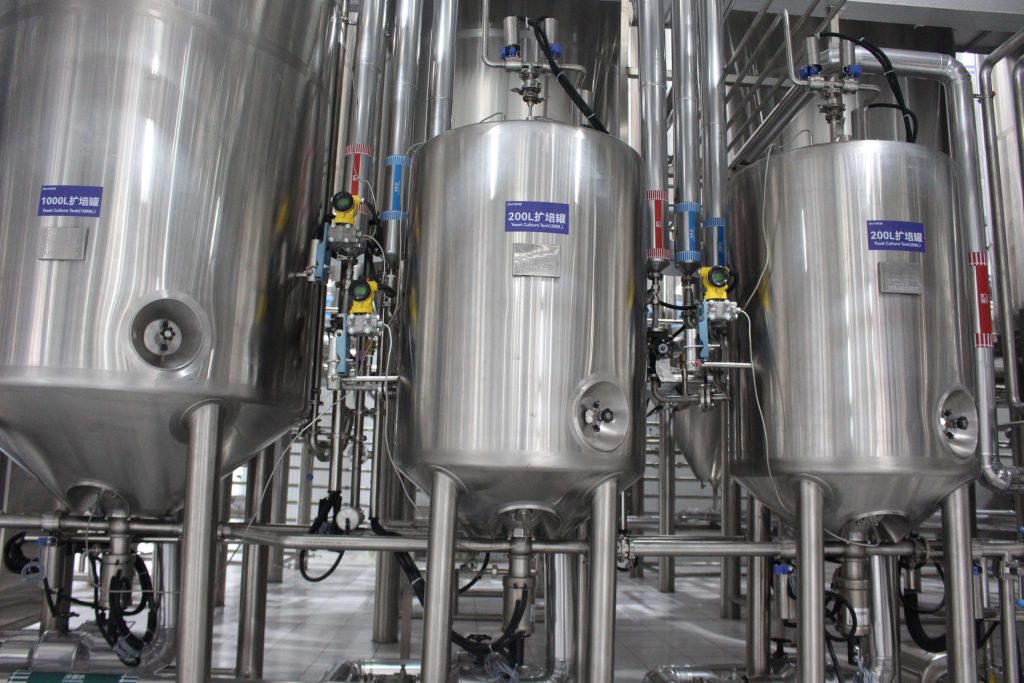Introduction

Craft beer has surged in popularity over the last few decades, with brewers pushing the boundaries of flavor and creativity. One of the unsung heroes of this brewing revolution is the yeast tank. These specialized vessels play a crucial role in fermentation, influencing the taste, aroma, and overall quality of the final product. This blog post will explore the importance of yeast tanks in craft beer production, their design, operation, and various types available.
Understanding Yeast Tanks
What is a Yeast Tank?
A yeast tank, also known as a fermentation tank, is a vessel where yeast is introduced to the wort (unfermented beer) to initiate the fermentation process. The yeast consumes the sugars in the wort, producing alcohol and carbon dioxide. The design of these tanks is tailored to optimize yeast activity and ensure a controlled environment for fermentation.
The Fermentation Process
Fermentation is a complex biochemical process where yeast converts sugars into alcohol and carbon dioxide. During this stage, various flavor compounds are also produced, contributing to the beer’s unique profile. Fermentation tanks are designed to maintain specific temperature and pressure conditions that favor the desired yeast strain’s metabolic activities.
Types of Yeast Tanks
Yeast tanks come in various shapes and sizes, each serving a different purpose in the brewing process. Here are some common types:
| Type of Yeast Tank | Description | Common Uses |
|---|---|---|
| Conical Fermenters | These have a cone-shaped bottom to facilitate yeast harvesting. | Primary fermentation and yeast collection. |
| Open Fermenters | Traditional tanks that allow for open fermentation. | Specialty beers and traditional brewing methods. |
| Jacketed Tanks | Equipped with cooling jackets to maintain temperature control. | Temperature-sensitive fermentation. |
| Brite Tanks | Used for conditioning and carbonating the beer post-fermentation. | Final stages of production before packaging. |
The Importance of Temperature Control
Yeast Activity and Temperature
Temperature is one of the most critical factors affecting yeast activity. Different yeast strains thrive at different temperatures. For instance, ale yeast generally ferments well at warmer temperatures (60-75°F), while lager yeast prefers cooler conditions (45-55°F). Yeast tanks must be equipped with temperature control systems to ensure optimal fermentation conditions.
Impact on Flavor Profile
The temperature at which fermentation occurs can significantly affect the beer’s flavor. Higher temperatures often lead to the production of esters and phenols, resulting in fruity and spicy notes. Conversely, cooler fermentation tends to produce cleaner flavors. Craft brewers often experiment with temperature variations in their fermentation tanks to create distinctive flavor profiles.
Oxygen Management in Yeast Tanks
The Role of Oxygen
While yeast requires oxygen during the initial growth phase, excessive oxygen during fermentation can lead to off-flavors and spoilage. Yeast tanks must be designed to minimize oxygen exposure once fermentation begins. This is crucial for preserving the beer’s integrity and enhancing its shelf life.
Oxygenation Techniques
Before fermentation, brewers often oxygenate the wort to promote healthy yeast growth. Various methods, including using an aeration stone or a whirlpool system, can be employed. After yeast is pitched, the tank should be sealed to prevent any oxygen from entering, ensuring a successful fermentation process.
Yeast Harvesting and Reuse
The Importance of Yeast Management
Yeast is not only a vital ingredient in beer production; it can also be a valuable asset. Many craft brewers practice yeast harvesting and reuse to improve efficiency and reduce costs. Proper management of yeast tanks allows brewers to collect and store yeast for future batches.
Techniques for Harvesting
Harvesting yeast from a fermentation tank involves careful techniques to ensure yeast viability. After fermentation, the yeast is often collected from the bottom of the conical fermenter. It can be rinsed and stored in sanitized containers for later use. This process not only saves money but also helps maintain consistent flavors across batches.
Cleaning and Sanitization of Yeast Tanks

Importance of Sanitation
Sanitation is critical in brewing, especially in yeast tanks. Any residual contaminants can spoil the beer or alter its flavor profile. Breweries must adhere to strict cleaning protocols to ensure that fermentation tanks are free of any unwanted microorganisms.
Cleaning Techniques
Brewers typically use a combination of hot water, caustic cleaners, and acid rinses to sanitize yeast tanks. Some advanced breweries also employ automated cleaning systems (CIP) that streamline this process, ensuring thorough cleaning without manual labor.
Conclusion
Yeast tanks are indispensable in the craft beer production process. From fermentation to yeast management, these tanks play a vital role in shaping the final product. Understanding their significance allows brewers to optimize their techniques and create unique, flavorful beers. As craft brewing continues to evolve, so too will the technology and methodologies surrounding yeast tanks, further enhancing the art of beer production.
FAQ
What is the ideal temperature for fermentation in yeast tanks?
The ideal temperature varies by yeast strain. Generally, ale yeast ferments best between 60-75°F, while lager yeast thrives at cooler temperatures of 45-55°F.
How often can yeast be reused?
Yeast can be reused several times, typically for 3-5 batches, depending on the yeast strain and fermentation conditions.
What is the difference between a conical fermenter and a brite tank?
A conical fermenter is used for the primary fermentation process, while a brite tank is used for conditioning and carbonating beer before packaging.
How do you prevent oxygen exposure in yeast tanks?
Oxygen exposure can be minimized by sealing the tank after pitching yeast and using proper techniques during the wort aeration stage.
Can yeast tanks influence the final flavor of the beer?
Yes, the design and operation of yeast tanks, including temperature control and oxygen management, significantly influence the beer’s flavor and aroma profile.

